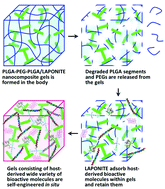当前位置:
X-MOL 学术
›
Biomater. Sci.
›
论文详情
Our official English website, www.x-mol.net, welcomes your
feedback! (Note: you will need to create a separate account there.)
Nanocomposite injectable gels capable of self-replenishing regenerative extracellular microenvironments for in vivo tissue engineering†
Biomaterials Science ( IF 5.8 ) Pub Date : 2018-01-16 00:00:00 , DOI: 10.1039/c7bm01167a Koji Nagahama 1, 2, 3, 4, 5 , Naho Oyama 1, 2, 3, 4, 5 , Kimika Ono 1, 2, 3, 4, 5 , Atsushi Hotta 5, 6, 7, 8 , Keiko Kawauchi 1, 2, 3, 4, 5 , Takahito Nishikata 1, 2, 3, 4, 5
Biomaterials Science ( IF 5.8 ) Pub Date : 2018-01-16 00:00:00 , DOI: 10.1039/c7bm01167a Koji Nagahama 1, 2, 3, 4, 5 , Naho Oyama 1, 2, 3, 4, 5 , Kimika Ono 1, 2, 3, 4, 5 , Atsushi Hotta 5, 6, 7, 8 , Keiko Kawauchi 1, 2, 3, 4, 5 , Takahito Nishikata 1, 2, 3, 4, 5
Affiliation

|
Injectable hydrogels are biomaterials that have the potential to provide scaffolds to cells for in situ tissue regeneration with a minimally invasive implantation procedure. The success of in vivo tissue engineering utilizing injectable gels depends on providing cells with appropriate scaffolds that present an instructive extracellular microenvironment, which strongly influences the survival, proliferation, organization, and function of cells encapsulated within gels. One of the most important abilities of injectable gels to achieve this function is to adsorb and retain a wide variety of requisite bioactive molecules including nutrients, extracellular matrices, and growth/differentiation factors within gels. Previously, we developed nanocomposite injectable gels fabricated by simple combination of common biodegradable copolymers, poly(lactide-co-glycolide)-b-poly(ethylene glycol)-b-poly(lactide-co-glycolide) (PLGA-PEG-PLGA), and synthetic clay nanoparticles (LAPONITE®). We revealed that the nanocomposite injectable gels strongly adsorb ECM molecules including collagen and heparin within gels and retain them due to the ability of LAPONITE® in synchronization with the degradation of PLGA-PEG-PLGA and subsequent release of the degradation products. Human dermal fibroblast cells cultured on the nanocomposite gels showed enough high cell viability and proliferation for at least a week. Moreover, various kinds of human cells encapsulated within the nanocomposite gels exhibited significantly higher survival, proliferation, and three-dimensional organization in comparison with the PLGA-PEG-PLGA gel, LAPONITE® gel, and Matrigel. Furthermore, transplantation of mouse myoblast cells with the nanocomposite gels in model mice of skeletal muscle injury dramatically enhanced tissue regeneration and functional recovery, whereas cell transplantation with the PLGA-PEG-PLGA gel did not. Thus, the nanocomposite injectable gels possess unique abilities to self-replenish the regenerative extracellular microenvironment within the gels in the body, demonstrating the potential utility of the nanocomposite injectable gels for in vivo tissue engineering.
中文翻译:

可自我补充可再生的细胞外微环境用于体内组织工程的纳米复合可注射凝胶†
可注射水凝胶是生物材料,具有通过微创植入程序为细胞提供支架以进行原位组织再生的潜力。体内成功利用可注射凝胶的组织工程依赖于为细胞提供适当的支架,这些支架具有指导性的细胞外微环境,该环境强烈影响封装在凝胶中的细胞的存活,增殖,组织和功能。可注射凝胶实现此功能的最重要能力之一是在凝胶内吸附和保留各种必需的生物活性分子,包括营养物质,细胞外基质和生长/分化因子。以前,我们开发了通过将常见的生物可降解共聚物(聚(丙交酯-共-乙交酯)-b-聚(乙二醇)-b-聚(丙交酯-共))简单组合而成的纳米复合可注射凝胶。-乙交酯)(PLGA-PEG-PLGA)和合成粘土纳米颗粒(LAPONITE®)。我们发现,纳米复合材料可注射凝胶在凝胶中强烈吸附包括胶原和肝素在内的ECM分子,并由于LAPONITE®与PLGA-PEG-PLGA降解以及随后释放降解产物同步的能力而将其保留。在纳米复合凝胶上培养的人真皮成纤维细胞至少一周有足够的高细胞活力和增殖能力。此外,与PLGA-PEG-PLGA凝胶,LAPONITE®凝胶和Matrigel相比,包裹在纳米复合凝胶中的各种人类细胞表现出更高的存活,增殖和三维组织。此外,在骨骼肌损伤的模型小鼠体内用纳米复合凝胶移植小鼠成肌细胞明显增强了组织再生和功能恢复,而用PLGA-PEG-PLGA凝胶进行细胞移植却没有。因此,纳米复合可注射凝胶具有独特的能力,可以自我补充体内凝胶中的再生细胞外微环境,这证明了纳米复合可注射凝胶在人体中的潜在用途。体内组织工程。
更新日期:2018-01-16
中文翻译:

可自我补充可再生的细胞外微环境用于体内组织工程的纳米复合可注射凝胶†
可注射水凝胶是生物材料,具有通过微创植入程序为细胞提供支架以进行原位组织再生的潜力。体内成功利用可注射凝胶的组织工程依赖于为细胞提供适当的支架,这些支架具有指导性的细胞外微环境,该环境强烈影响封装在凝胶中的细胞的存活,增殖,组织和功能。可注射凝胶实现此功能的最重要能力之一是在凝胶内吸附和保留各种必需的生物活性分子,包括营养物质,细胞外基质和生长/分化因子。以前,我们开发了通过将常见的生物可降解共聚物(聚(丙交酯-共-乙交酯)-b-聚(乙二醇)-b-聚(丙交酯-共))简单组合而成的纳米复合可注射凝胶。-乙交酯)(PLGA-PEG-PLGA)和合成粘土纳米颗粒(LAPONITE®)。我们发现,纳米复合材料可注射凝胶在凝胶中强烈吸附包括胶原和肝素在内的ECM分子,并由于LAPONITE®与PLGA-PEG-PLGA降解以及随后释放降解产物同步的能力而将其保留。在纳米复合凝胶上培养的人真皮成纤维细胞至少一周有足够的高细胞活力和增殖能力。此外,与PLGA-PEG-PLGA凝胶,LAPONITE®凝胶和Matrigel相比,包裹在纳米复合凝胶中的各种人类细胞表现出更高的存活,增殖和三维组织。此外,在骨骼肌损伤的模型小鼠体内用纳米复合凝胶移植小鼠成肌细胞明显增强了组织再生和功能恢复,而用PLGA-PEG-PLGA凝胶进行细胞移植却没有。因此,纳米复合可注射凝胶具有独特的能力,可以自我补充体内凝胶中的再生细胞外微环境,这证明了纳米复合可注射凝胶在人体中的潜在用途。体内组织工程。











































 京公网安备 11010802027423号
京公网安备 11010802027423号